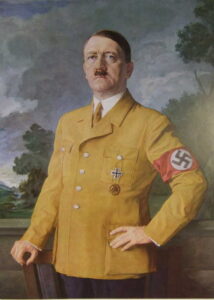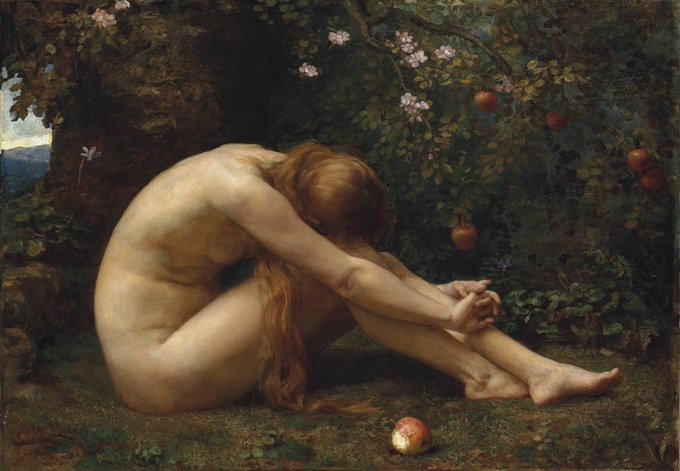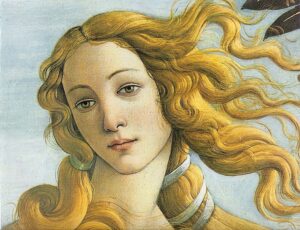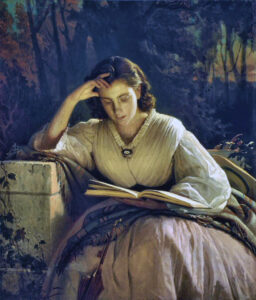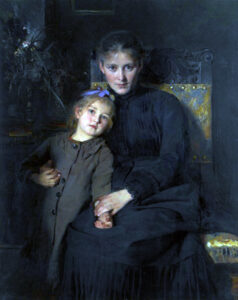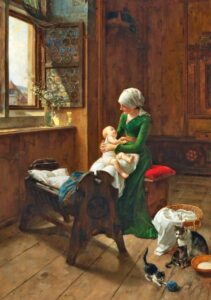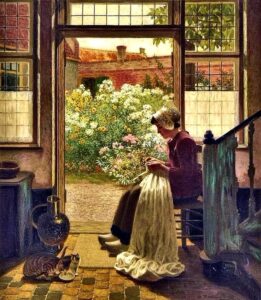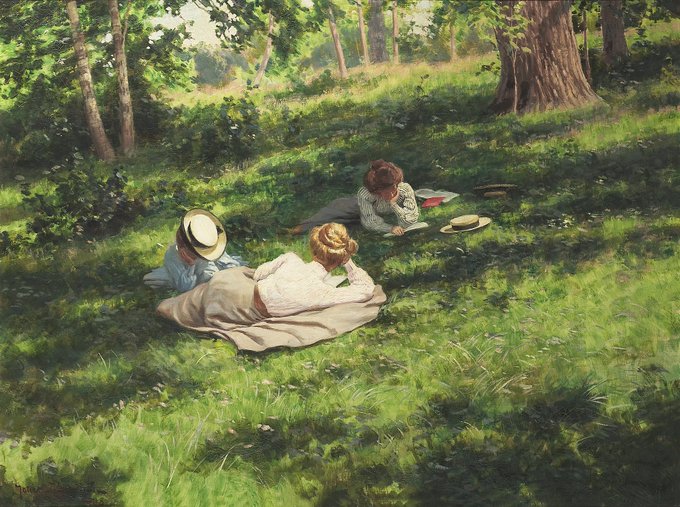Happy birthday Uncle Adolf!
Category: Painting
2 founding fathers
In the middle of the year I added a post in which I was alarmed about the existence of serial child killers in the US. These last few days, however, I have seen a lot of videos of horrific murders committed by American adults on other adults.
I won’t mention the names of the perpetrators, which you can easily find out by looking them up on YouTube. Still, I am now thinking of a young Aryan lad in whose room his mother found a bag containing a human head (in police interrogation the lad gloated that he had destroyed the corpse’s eyes with a knife); a woman who had killed her mother and hid her body in the garage until the cops found her; another woman who killed seven of her newborn babies and collected their corpses in boxes that began to smell bad; a man who suffered from the same disease that depressed Robin Williams but, unlike the famous actor, butchered his wife with a small but sharp knife (the video reveals that the policeman who entered the crime scene had to get out and throw up the turkey because of what he had seen, as the day before had been Thanksgiving Day), etcetera.
There is no doubt that American society is sick. But the serious thing is that practically no one, not even white nationalists, realises the causes of the spiritual sickness that has befallen their society. Only Americans like Francis Parker Yockey began to sense the cause, but his best-known work, Imperium, was written in prose so opaque that, in my opinion, it is no longer of any use to us in this century.
Writing in prose so clear and transparent that the essentials can be said in a short blog post, the darkest hour (Kali Yuga) not only of the US but of the West began in 1945. Two of the featured posts that can be read on the menu of this site, ‘Founding Myth’ and ‘The Iron Throne’ deal with the matter and I need not repeat myself. What I would like to clarify today is something else.
I have recently said some very harsh things about the ‘Founding Father’ of the Americans, George Washington, because of his philo-Semitism. But I, born south of the Rio Grande, could say the same about the Founding Father of Mexico: Hernán Cortés.
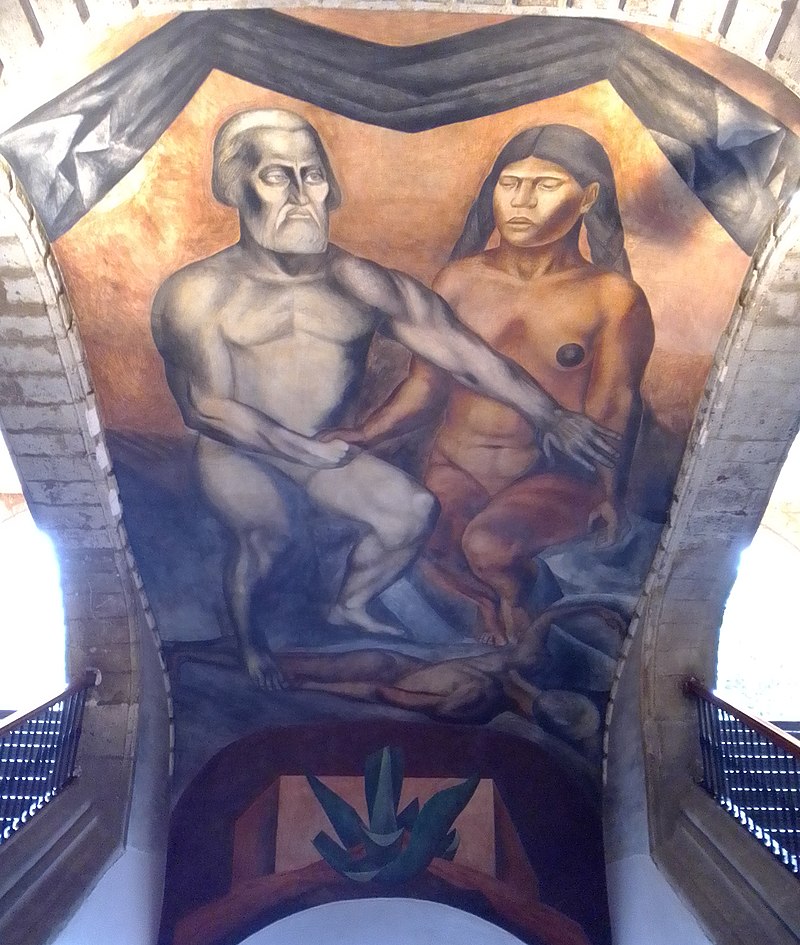
Cortés and La Malinche is a mural by José Clemente Orozco frescoed in 1926. It is preserved on the main staircase of the Antiguo Colegio de San Ildefonso, located in the centre of Mexico City.
Cortés not only conquered Mexico-Tenochtitlan in 1519-1521, the seat of the Aztec empire, but also initiated the interbreeding of Iberian White and American Indian. One need only travel to contemporary Mexico to see the ravages of this miscegenation sanctioned by both the Catholic Church and the Spanish Crown.
Now, as I have also said recently, the pre-Christian Visigoths of ancient Hispania burned at the stake any couple who dared to procreate a mongrel baby. What a reversal of values between this taboo of the pagan Goths and the 16th-century mixing perpetrated throughout the American continent! (remember that a large part of what is now the US belonged to New Spain).
This miscegenation on a scale never seen before was, in my opinion, worse than Washington’s philo-Semitism because it condemned the newly discovered continent to perennial underdevelopment, at least in the part that was colonised by the Spaniards and the Portuguese.
By expressing myself in this way about the country of my birth, I have become such an outcast that I have not a single friend, so I never carry with me my cellphone (which I only use for my bank account). But what I want to get at is that, if I express myself in this way about Cortés and the Iberian conquistadors who mixed their blood, why shouldn’t I also express myself harshly about the Founding Father of the neighbouring country to the north and his philo-Semitic epigones?
Might is right, 10
by Ragnar Redbeard [1]
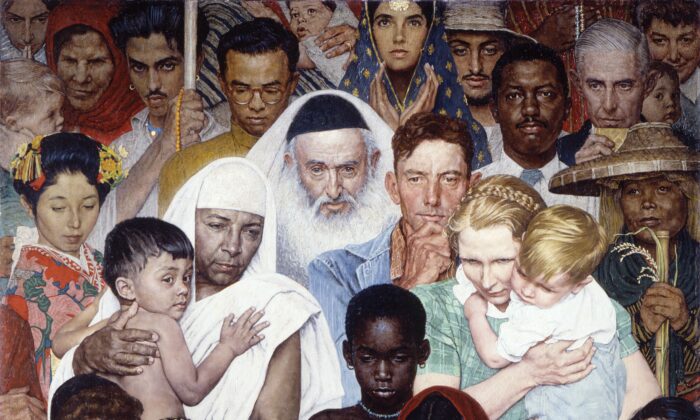
The Golden Rule by Norman Rockwell (oil on canvas). Fifteen years after WW2, The Saturday Evening Post relaxed its stance on the depictions of races other than white people. One of the first multiracial images to grace the cover of the Post was Rockwell’s The Golden Rule.
Is the Golden Rule a rational rule? — Is it not rather a menial rule — a coward rule — a best-policy rule? Why is it ‘right’ for one man to do unto others as he would have others do to him and, what is right? If ‘others’ are unable to injure him or ‘do good’ to him, why should he consider them at all? Why should he take any more notice of them than of so many worms? If they are endeavouring to injure him, and able to do it, why should he refrain from returning the compliment? Should he not combat them, does not that give them carte-blanche to injure and destroy him? May it not be ‘doing good’ to others, to war against them, to annihilate them? May it not also be ‘good’ for them to war against others? (Again, what is ‘good’?)
Is it reasonable to ask preying animals, to do unto others as they would be done by? — If they acted accordingly would they, could they survive? If some only accepted the Golden Rule as their guiding moral maxim, would they not become a prey to those who refused to abide thereby?
Upon what reasonable and abiding sanction does this ‘Rule’ rest? — Has it ever been in actual operation among men? — Can it ever be successfully practiced on earth — or anywhere else? — Did Jesus Christ practice it himself upon all occasions? — Did His apostles, his ‘sons of thunder’ practice it? — Did Peter the boaster do so, when he ‘denied Him’ for fear of arrest at the camp-fire? — Did Judas the financier, when he sold him for net cash? Also, how many of his modern lip-servants actually practice it in their daily business intercourse with each other? How Many?
These questions require no formal answering. They answer themselves in the asking. And here it must be remembered that the best test of a witness, is cross-examination. ‘Do unto others as you would have others do to you.’ No baser precept ever fell from the lips of a feeble Jew.
It is from alleged moralisms of this sort, and fabulous ‘principles’ that our mob orators, our communards, revivalists, anarchists, red-republicans, democrats, and other mob-worshippers in general derive the infernal inspiration that they are perpetually hissing forth. Even the subversive pyrotechnic watchwords of their mephisto-millennium, are to be found in the ‘holy gospels.’ Is it not written, ‘and God sendeth angels to destroy the people?’ — Behold! these men are the ‘angels’ that He sends: — politicians and reformers!
‘Love one another’ you say is the supreme law, but what power made it so? — Upon what rational authority does the Gospel of Love rest? — Is it even possible to practice, and what would result from its universal application to active affairs? Why should I not hate mine enemies, and hunt them down like the wild beasts that they are? Again I ask, why? If I ‘love’ them does that not place me at their mercy? Is it natural for enemies to ‘do good’ unto each other and, what is ‘good’? Can the torn and bloody victim ‘love’ the blood-splashed jaws that rend it limb from limb? Are we not all predatory animals by instinct? If humans ceased wholly from preying upon each other, could they continue to exist?
‘Love your enemies and do good to them that hate you and despitefully use you,’ is the despicable philosophy of the spaniel that rolls upon its back, when kicked. Obey it, O! reader, and you and all your posterity to the tenth generation shall be irretrievably and literally damned. They shall be hewers of wood, and carriers of water, degenerates, Gibeonites. But hate your enemies with a whole heart, and if a man smite you on one cheek, smash him down; smite him hip and thigh, for self-preservation is the highest law.
He who turns the ‘other cheek’ is a cowardly dog — a Christian dog.
Give blow for blow, scorn for scorn, doom for doom, with compound interest liberally added thereunto. Eye for eye, tooth for tooth, aye four-fold, a hundredfold. Make yourself a Terror to your adversary and when he goeth his way, he will possess much additional wisdom to ruminate over. Thus shall you make yourself respected in all the walks of life, and your spirit — your immortal spirit — shall live, not in an intangible paradise, but in the brains and thews of your aggressive and unconquerable sons. After all, the true proof of manhood is a splendid progeny; and it is a scientific axiom that the timid animal transmits timidity to its descendents.
If men lived ‘like brothers’ and had no powerful enemies (neighbors) to contend with and surpass, they would rapidly lose all their best qualities; like certain oceanic birds that lose the use of their wings, because they do not have to fly from pursuing beasts of prey. If all men had treated each other with brotherly love since the beginning, what would have been the result now? If there had been no wars, no rivalry, no competition, no kingship, no slavery, no survival of the Toughest, no racial extermination, truly what a festering ‘hell fenced in’ this old globe would be?
_____________
[1] According to Wikipedia it was Arthur Desmond (1859-1929) who wrote under the pen name ‘Ragnar Redbeard’.
